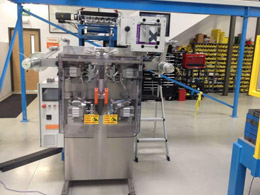Want a Leaner Hardware Inventory? Take a Look at AFIS

The bagger is fed by the flipper to seal each compartment’s contents into perforated bags in AFIS.
Q. I’m interested in implementing a custom hardware kitting system for an aircraft component assembly process. What expertise does Delta Sigma Company (DSC) have in this area?
A. DSC has recently broadened our engineer-to-order (ETO) skill set to include hardware kitting for aerospace assembly operations. We’ve developed the Automated Fastener Installation System (AFIS), a solution that delivers automatically kitted fasteners, which have been chemically cleaned and prepared for use, directly to the technicians in sealed labeled bags at the precise location needed. This automated kitting capability makes inventory control more accurate and better organized, which in turn enables a production operation to run much leaner and more efficiently.
AFIS components
AFIS consists of six components or stations in the automated kitting process:
- Load station — Here, each box of fasteners is inputted into the system (e.g., by scanning a bar code or via the HMI). Then the fasteners are removed from the box and weighed, and the system uses the weight to calculate the number of fasteners. Finally, the fasteners are placed in an empty bin, which the picker head (discussed next) puts on a bin rack behind the station.
- Picker head — This device travels the entire grid of bin racks along a track and can rapidly grab bins and bring them to the appropriate station.
- Sort station — Here, the parts needed for the as-built condition of the assembly are sorted. The picker head brings a bin to the sort station and the HMI prompts the user to place a given quantity of parts onto the scale. The part is weighed/counted according to the specified quantity needed, then dropped into a compartmentalized tray. Each compartment in the tray contains just one part number of the specified quantity. The trays then exit on a conveyor to be chemically processed with cleaner and have promoter applied.
- Tray-handling gantry — This station receives the trays from the sort station and places them in the chemical processing machines. After processing, the gantry sets the trays on a surface to dry. Once the processed parts are dry, the gantry carries the trays off to the flipper unit (the last component), then returns empty trays back to the sort station to be filled.
- Clean and promote units — These machines chemically clean and promote the contents of the trays. Parts that do not require processing are placed in a tray that bypasses these systems.
- Flipper unit and bagger — The flipper unit takes a tray and flips it upside down over the bagger, emptying 1 of 25 of the tray compartments at a time, so that the bagger can bag only one part number with the correct number of fasteners needed per bag. Each compartment’s contents is bagged in a “sausage link” style perforated bag chain, then prints the relevant information on each bag (e.g., part number, quantity, destination, user, aircraft tail number). The bags can be torn off their perforations and delivered to the technician who needs the fasteners.
Upcoming integration with ProjectionWorks
In the next implementation phase of AFIS, a ProjectionWorks product (such as AssemblyWorks) will visually guide technicians through a series of measurement tasks and use that information to determine the particular type and number of fasteners needed for the as-built assembly. This information will then be transferred into AFIS, which will use it to retrieve, process, and bag the parts in the order they will be installed. This effectively makes ProjectionWorks the “input” for AFIS.
Additionally, AFIS bags are printed with a bar code that contains information about the install locations for the fasteners in that bag. The technician would simply scan the bag at the AssemblyWorks station with a barcode scanner, and instantly the install locations of the contents of just that one bag are projected onto the assembly being worked on.
Aerospace applications
AFIS is funded by the Air Force Research Laboratory as part of an Air Force Small Business Innovation Research (SBIR) grant to reduce costs and increase efficiencies in the U.S. Department of Defense’s F-35 Lightning II program. However, the abilities of the AFIS system are not limited to any one aircraft, manufacturer, or even fasteners. DSC envisions this technology to have a wide range of applications in aerospace production operations.
[cta]Want to learn more about AFIS and how it can make your production operations leaner, more accurate, and more cost and time efficient? Contact DSC at (770) 575-5100 or email us at info@deltasigmacompany.com, and we’ll be happy to discuss how AFIS’s automated fastener kitting could work in your manufacturing application.[/cta]

